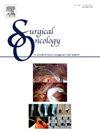Prediction of early recurrence as a marker of surgical futility in pancreatic adenocarcinoma
IF 2.4
4区 医学
Q3 ONCOLOGY
引用次数: 0
Abstract
Background
Long-term survival after resection for pancreatic ductal adenocarcinoma (PDAC) is impaired by very high recurrence rates. When recurrence occurs within 6 months (early recurrence: ER) the benefit of surgery is equivalent to palliative chemotherapy in unresectable patients. Therefore, ER is a surrogate of surgical futility in PDAC.
Materials and methods
To investigate predictive factors of ER and its impact on survival, a training and a validation cohort of prospectively collected patients who underwent surgery for resectable or borderline-resectable PDAC were analyzed in two independent Pancreas Units during the same period. Logistic regression model on the training cohort identified independent predictors of ER, used to build a prognostic risk-score then tested on the validation cohort.
Results
Out of 176 patients in the training cohort, 21.6 % experienced ER, with significant impact on survival (OS: 9.7 months vs. 32.7 months for ER vs. late/no recurrence, respectively). At multivariable analysis, three independent risk factors for ER were identified: Ca19.9 > 100 U/mL, G3 tumors and lack of adjuvant chemotherapy. Based on such features the derived ER-score stratified three prognostic classes at incremental risk of ER (12 %, 35 % and 53 %) with different OS (31.1, 19.7 and 9.3 months, respectively, p < 0.001). The ER predictive score was then tested on a validation cohort of 242 patients, 22.3 % of whom underwent ER. Despite significant differences in tumor-related features, the score was able to discriminate among the predicted ER-risk classes (15 %, 27 % and 53 %, respectively) and forecast significantly different OS (5.8, 19 and 31.1 months, p > 0.001). The discriminative capability of the score in the two cohorts was similar (training AUC = 0.72 vs. validation AUC = 0.68, p = 0.28).
Conclusion
An externally validated clinical score, able to identify three prognostic classes at incremental risk of developing ER after resection of PDAC is provided. In patients at high risk of ER, prediction of surgical futility may help in decision-making.
预测胰腺癌早期复发作为手术失败的标志
背景:胰腺导管腺癌(PDAC)切除术后的长期生存受到非常高的复发率的影响。当复发发生在6个月内(早期复发:ER),手术的好处相当于姑息性化疗对无法切除的患者。因此,ER是PDAC手术无效的替代指标。材料和方法为了研究ER的预测因素及其对生存的影响,在同一时期,在两个独立的胰腺单位对前瞻性收集的接受可切除或边缘性可切除PDAC手术的患者进行了训练和验证队列分析。训练队列的Logistic回归模型确定了ER的独立预测因子,用于建立预后风险评分,然后在验证队列中进行测试。结果在176名接受培训的患者中,21.6%的患者经历了ER,这对生存有显著影响(ER与晚期/无复发的生存期分别为9.7个月和32.7个月)。在多变量分析中,确定了三个独立的ER危险因素:Ca19.9 >;100 U/mL, G3肿瘤,缺乏辅助化疗。基于这些特征,得出的ER评分将不同OS(分别为31.1个月、19.7个月和9.3个月)的ER增量风险(12%、35%和53%)分为三个预后类别,p <;0.001)。然后在242例患者的验证队列中测试ER预测评分,其中22.3%的患者接受了ER治疗。尽管肿瘤相关特征存在显著差异,但该评分能够区分预测er风险类别(分别为15%,27%和53%)和预测显着不同的OS(5.8, 19和31.1个月,p >;0.001)。两个队列中得分的判别能力相似(训练AUC = 0.72 vs验证AUC = 0.68, p = 0.28)。结论提供了一个外部验证的临床评分,能够识别PDAC切除术后发生ER风险增加的三个预后类别。在ER高危患者中,预测手术无效可能有助于决策。
本文章由计算机程序翻译,如有差异,请以英文原文为准。
求助全文
约1分钟内获得全文
求助全文
来源期刊

Surgical Oncology-Oxford
医学-外科
CiteScore
4.50
自引率
0.00%
发文量
169
审稿时长
38 days
期刊介绍:
Surgical Oncology is a peer reviewed journal publishing review articles that contribute to the advancement of knowledge in surgical oncology and related fields of interest. Articles represent a spectrum of current technology in oncology research as well as those concerning clinical trials, surgical technique, methods of investigation and patient evaluation. Surgical Oncology publishes comprehensive Reviews that examine individual topics in considerable detail, in addition to editorials and commentaries which focus on selected papers. The journal also publishes special issues which explore topics of interest to surgical oncologists in great detail - outlining recent advancements and providing readers with the most up to date information.
 求助内容:
求助内容: 应助结果提醒方式:
应助结果提醒方式:


